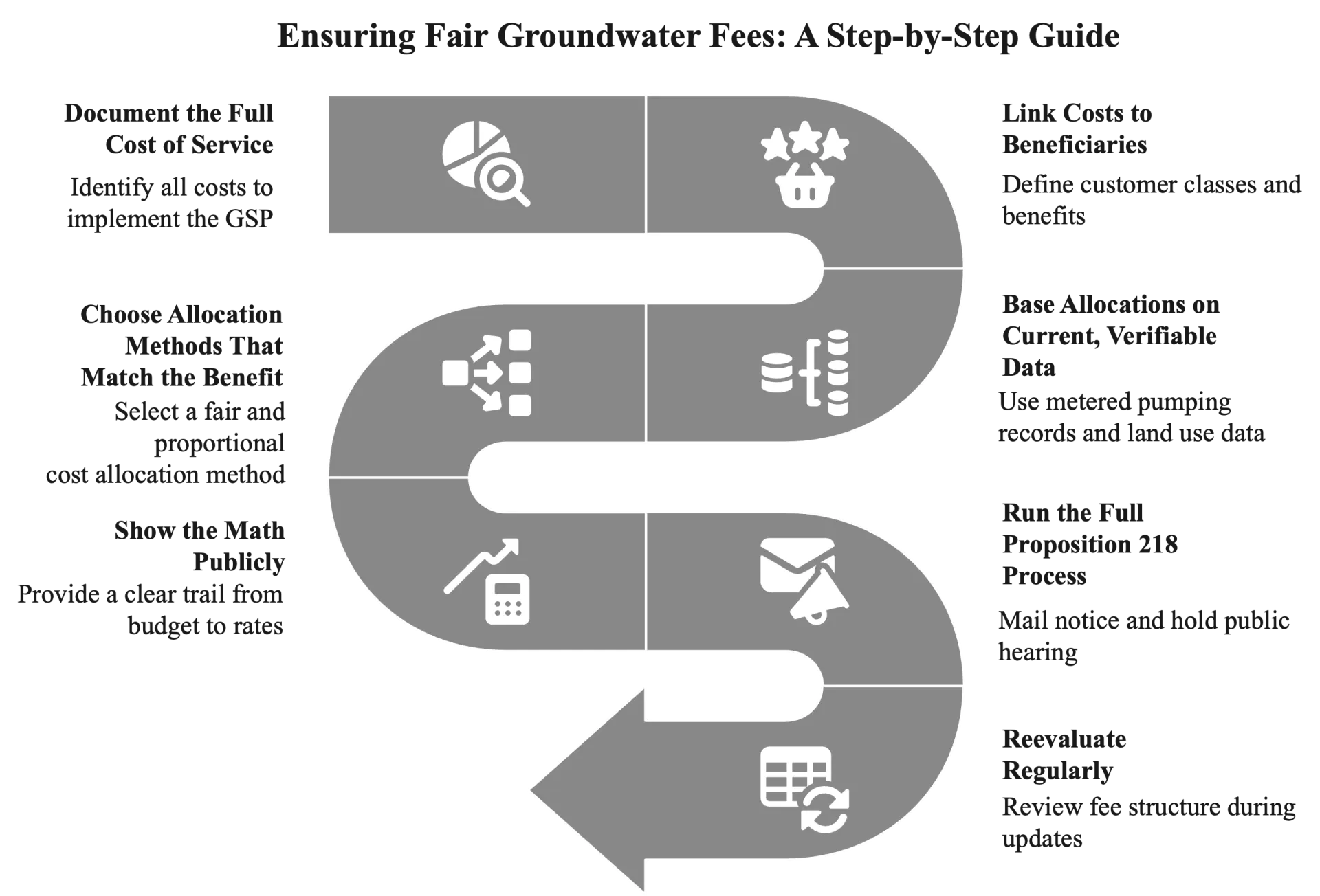Introduction
In California, it’s easy to think of drinking water systems and groundwater management as two separate worlds. Cities and water districts set rates for tap water. Groundwater Sustainability Agencies (GSAs) oversee aquifer health and pumping limits under the Sustainable Groundwater Management Act (SGMA). But they are linked by a single, powerful legal rule: Proposition 218. A recent California Court of Appeal decision, Patz v. City of San Diego, 2025, shows just how closely these worlds are connected and why groundwater managers should be paying attention.
The Patz case centered on San Diego’s tiered residential water rates. The city charged customers more per gallon as their water use increased, arguing that higher-volume users drove up infrastructure costs and should pay more. The court rejected this approach. It found that the city had not proven that each tier reflected the actual, proportional cost of providing service. San Diego claimed that low-use customers were served with cheaper, local reservoir water and high-use customers with more expensive imported water. But the system mixed these supplies and the city had no data showing that the allocation matched reality. The city also applied tiered rates only to residential customers, while commercial users paid a flat rate for the same water.
The result was a violation of Proposition 218’s requirement that charges match the proportional cost of service to each parcel. The decision, combined with a strong dissent, has set the stage for possible California Supreme Court review. But for now, it reinforces a strict reading of Prop 218 that demands verifiable cost-of-service evidence and prohibits using rate structures primarily as a behavioral tool.
This matters for SGMA because many GSAs rely on property-related fees under Proposition 218 to fund their work, particularly when those fees are tied to groundwater pumping or parcel-based services. Other funding mechanisms also exist. These include regulatory fees under Proposition 26, which support administrative or compliance programs, and voter-approved special taxes under Proposition 13, which are more difficult to pass. Some agencies have considered tiered pumping charges to encourage conservation and meet sustainability targets under SGMA. Many GSAs currently justify pumping fees as mitigation for overdraft impacts. After Patz, those approaches carry heightened legal risk. A GSA cannot justify tiers simply by pointing to higher pumping volumes or sustainability goals; it must show with current, defensible data that each tier reflects real differences in the cost of service. If all groundwater comes from the same aquifer, there must be clear evidence that serving one tier truly costs more than serving another. And if different user classes such as agriculture and municipal pumpers are treated differently, the agency must be able to prove why.
The Department of Water Resources’ Funding SGMA Implementation guide already spells out how GSAs can build this kind of legal defensibility (DWR, 2024). It calls for agencies to document the full cost of service, link costs to specific beneficiaries, and base allocations on real, contemporaneous data such as metered pumping records or land use patterns. It emphasizes transparency in showing how budgets translate into per-unit rates, requires a formal notice and protest process, and encourages regular reevaluation to keep fees aligned with actual operations.
Issue | San Diego (Patz) | Potential GSA Scenario |
| Tiered Charges | Three residential water tiers with steep price jumps to encourage conservation. | Three pumping tiers for agricultural users with higher rates at higher volumes to discourage over pumping. |
| Stated Rationale | High use customers allegedly caused higher peak demand costs; conservation also a goal. | Large pumpers allegedly cause more infrastructure wear, deeper pumping costs, and monitoring expenses; conservation also a goal. |
| Cost Allocation Method | Claimed low use tiers received cheaper reservoir water, high use tiers received expensive imported water. | Claimed low volume pumpers use “cheaper” shallow aquifer water, high volume pumpers draw from “costlier” deep aquifer zones. |
| Reality Check | All water sources were commingled; no proof of separate supply to tiers. | All groundwater is from the same aquifer; no proof of distinct delivery or measurable cost difference. |
| Data Used | Historical averages, not customer specific or real time data. | Historic basin pumping patterns, not current metering or cost tracking per tier. |
| Class Treatment | Tiers applied only to residential customers; commercial customers paid flat rates. | Tiers applied only to agricultural users; municipal and industrial pumpers charged flat rates for the same water. |
| Court’s Finding | Violated Proposition 218 charges were not proportional to the actual cost of service. | At risk of violating Proposition 218 if costs are not documented, proportional, and supported by verifiable data. |
These steps were always good practice. After Patz, they are essential. The same proportionality rules that brought down San Diego’s drinking water rates apply equally to groundwater extraction fees. If a GSA sets rates without robust cost justification, it risks not only legal challenges but also costly refunds or funding gaps that could derail projects.
How GSAs Can Avoid a Patz Problem
Proposition 218 allows tiered or differentiated groundwater fees if every rate is supported by a transparent, proportional cost of service analysis. GSAs can reduce legal risk by following these practices from the Department of Water Resources’ Funding SGMA Implementation guide (DWR, 2024):

The lessons from Patz are straightforward. The same proportionality rules that brought down San Diego’s drinking water rates apply equally to groundwater extraction fees. If a GSA sets rates without robust cost justification, it risks legal challenges, and funding gaps that can slow or halt implementation. Drinking water law and groundwater law are connected in California. Agencies on both sides should prepare to defend their fees with current data and a clear cost of service analysis.
References:
DWR. (2024). Demonstrating Groundwater Sustainability Plan Implementation: A Guide to Annual Reports, Periodic Evaluations, Funding SGMA Implementation. https://water.ca.gov/-/media/DWR-Website/Web-Pages/Programs/Groundwater-Management/Sustainable-Groundwater-Management/Best-Management-Practices-and-Guidance-Documents/Files/240321_SGMO_FundingGuide_FINAL.pdf
Patz v. City of San Diego, No. E083543 (California Court of Appeal, Fourth Appellate District, Division Two July 30, 2025). https://law.justia.com/cases/california/court-of-appeal/2025/e083543.html

